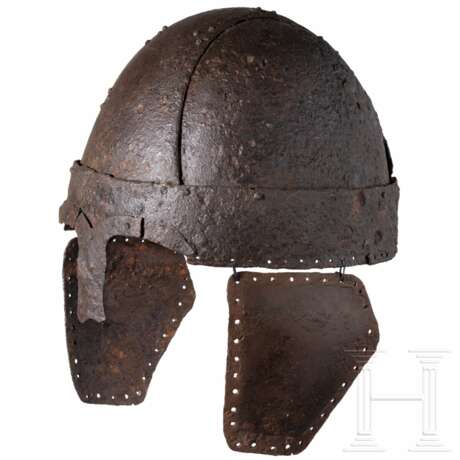ID 1323337
Los 4126 | Bandhelm vom Typ St. Vid/Narona, spätes 5. - 6. Jhdt.
Eiserner Helm mit Kalotte aus vier verschweißten Teilstücken. Zwei seitliche "Kugelsegmente" von unten her an ein mittleres, an beiden Seiten deutlich eingezogenes Band geschweißt, das sich von der Stirn zum Nacken zieht. An den Kanten des Mittelbandes befinden sich gegenüberliegende Dreiergruppen von Pseudonieten. Keiner der außen sichtbaren Nietköpfe gehört zu einem Niet, der beide Bleche durchstößt. Die "Nietköpfe" haben daher primär dekorativen Zweck, leiten sich aber von anderen spätantiken Helmen mit echter Nietverbindung als "typologisches Rudiment" ab. Am linken unteren Rand des mittleren Helmbands kommt noch ein weiteres dekoratives Merkmal zum Vorschein, das bei den bisher bekannten Helmen dieses Typs nicht beschrieben ist: Ein Blechband mit einem Perlrand an der Kante (eine Reihung kleiner Eisenbuckel, ähnlich den Pseudonieten) ist zwischen mittlerem Band und seitlichem "Kugelsegment" gesteckt, von dem nur dieser Perlrand zu sehen war. Reste dieses Bandes lassen sich bis zum Scheitel verfolgen. Auf der Vorderseite und der gegenüberliegenden Kante des Mittelbandes sind Reste dieses Bandes kaum erkennbar. Dennoch dürften die gesamten Kanten des mittleren Bandes damit verziert gewesen sein. Um die so aus drei Teilen gefügte Kalotte herum am Rand ein 5 cm hohes Eisenband gelegt, das in den oberen ca. 1 - 2 cm mit der dreiteiligen Kalotte verschweißt ist und diese ca. 3 - 4 cm nach unten überragt. Das Eisenband überlappt sich ca. 5 mm im Nackenbereich, wo es ebenfalls verschweißt ist. Zwei Nieten auf der Außenseite des Bandes nahe der Kante der Überlappung sind wieder nur Pseudonieten. Nur die "Nietköpfe" sind auf der Außenseite sichtbar und wohl von innen her durchgedrückt. Dies gilt gleichermaßen für "Nietköpfe" entlang der oberen Kante des Eisenbands, die eine nicht vorhandene Vernietung der Kalottensegmente mit dem Eisenband suggerieren. Dieses technische Merkmal der Pseudonieten ist auch als typisch für die bisher bekannten Helme dieses Typs beschrieben. Vorliegender Helm passt somit gut in das bisher bekannte Erscheinungsbild dieses Helmtyps. Auf der Stirnseite befinden sich zwei seichte Augenausschnitte, über denen ein Nasal befestigt ist. Diesmal mit echten Nieten, welche Nasal und Randband durchstoßen. Der rechte Augenbogen ist noch mit dem Randband verbunden, ebenso das spitze linke Ende. Das ausgebrochene Mittelteil ist passgenau mit einem noch steckenden Niet in das vorhandene Nietloch geklebt worden. Die seichten Augenauschnitte mit darüber befestigtem Nasal sind typisch für spätrömische Helme vom Typ Der-el-Medineh, die teils ähnliche, insgesamt aber abweichende Konstruktionsprinzipien haben. Seichte Augenausschnitte mit nur angedeutetem Nasal haben auch die frühbyzantinischen Spangenhelme des späten 5. bis 6. Jahrhunderts. Die Seiten des Randbandes besitzen eine Reihe von Durchstoßungen zur Befestigung eines Helmfutters. Neben dem Nasal sind auch zwei Wangenklappen erhalten, die jedoch beide stark restauriert und mit Kunstharz stabilisiert sind, insbesondere die linke Wangenklappe. Dennoch sind beide in ihrer Umrissform mit den rings um den Rand verlaufenden Durchbohrungen gut erhalten. Diese Durchbohrungen dienten gleichfalls der Befestigung an einem Helmfutter, das zugleich auch Wangenklappe und Kalotte anstelle eines Scharniers verbunden hatte. Ein typisches Konstruktionsmerkmal für spätrömische Helme des 4. Jhdts. Die Rückseite der Wangenklappen verläuft gerade, die Vorderseite mit einem stumpfen Winkel, der im oberen Teil der Wangenklappe umbricht.
Länge des Helms 22,5 cm. Breite 18,3 cm. Höhe 17 cm. Höhe der Wangenklappen 12 cm. Oberfläche mit leichten Korrosionsnarben. Insgesamt ausgezeichnet erhalten mit gut wahrnehmbaren technischen Details. Erhaltene Höhe des Nasals 7,5 cm. Ausgesprochen seltener und in seiner Vollständigkeit der vorhandenen Einzelteile und Komponenten einzigartiger spätantiker Helm, der das Wissen um die Konstruktion der bisher bekannten Bandhelme erweitert, darunter mehrere bisher nur an diesem Helm eindeutig erkennbare Merkmale. Es handelt sich um einen spätantiken Helmtyp, der sicher im spätrömischen Reich produziert worden ist und dessen vereinzeltes Vorkommen in außerrömischen Kontexten als mediterraner Export anzusehen ist. Die genaue Zeitstellung dieser Helme zwischen spätem 5. und 6. Jahrhundert bedarf noch weiterer Forschungen. Es ist davon auszugehen, dass dieser Helmtyp chronologische Überlappungen mit anderen spätantiken Helmtypen hat und zumindest teilweise gleichzeitig mit diesen Helmtypen (z.B. Berkasovo, Biberwier, Der-el-Medineh; frühbyzantinische Spangenhelme) existierte.
A band helmet of the St Vid/Narona type, late 5th - 6th century A.D.
A band helmet of the St Vid/Narona type, late 5th - 6th century A.D.
Iron helmet with a calotte made of four welded sections. Two lateral ‘spherical segments’ welded from below to a central band that is clearly indented on both sides and extends from the forehead to the nape. There are opposing groups of three pseudo-rivets on the edges of the centre band. None of the externally visible rivet heads belong to a rivet that pierces both sheets. The ‘rivet heads’ therefore have a primarily decorative purpose, but are derived from other late antique helmets with a genuine rivet connection as a ‘typological rudiment’. Another decorative feature appears on the lower left edge of the central helmet band, which is not described in the helmets of this type known to date: a sheet metal band with a beaded edge (a row of small iron bosses, similar to pseudo-rivets) is inserted between the central band and the lateral ‘spherical segment’, of which only this beaded edge was visible. Remains of this band can be traced up to the crown. On the front and the opposite edge of the centre band, remnants of this band are barely visible. Nevertheless, the entire edges of the centre band were probably decorated with it. A 5 cm high iron band was placed around the edge of the three-part calotte, which is welded to the three-part calotte in the upper approx. 1 - 2 cm and protrudes approx. 3 - 4 cm downwards. The iron band overlaps approx. 5 mm in the neck area, where it is also welded. Two rivets on the outside of the strap near the edge of the overlap are again only pseudo-rivets. Only the ‘rivet heads’ are visible on the outside and are probably pressed through from the inside. This also applies to the 'rivet heads' along the upper edge of the iron band, which suggest that the spherical segments are riveted to the iron band. This technical feature of the pseudo-rivets is also described as typical of the helmets of this type known to date. The present helmet therefore fits in well with the previously known appearance of this helmet type. There are two shallow eye cut-outs on the front, above which a nasal is attached. This time with real rivets that pierce the nasal and rim band. The right eye bow is still attached to the rim band, as is the pointed left end. The broken-out middle section has been glued into the existing rivet hole with a rivet that is still in place. The shallow eye cut-outs with a nasal attached above them are typical of late Roman helmets of the Der-el-Medineh type, which have partly similar but generally different construction principles. The early Byzantine clasp helmets of the late 5th to 6th century also have shallow eye cut-outs with only a hint of a nasal. The sides of the rim band have a series of perforations for attaching a helmet lining. In addition to the nasal, two cheek flaps have also survived, although both have been heavily restored and stabilised with synthetic resin, especially the left cheek flap. Nevertheless, both are well preserved in their outline shape with the perforations running around the edge. These perforations were also used to attach the helmet to a helmet lining, which also connected the cheek flap and skull instead of a hinge. A typical design feature for late Roman helmets of the 4th century. The back of the cheek flaps runs straight, the front with an obtuse angle that breaks in the upper part of the cheek flap.
Length of the helmet 22.5 cm. Width 18.3 cm. Height 17 cm. Height of the cheek pieces 12 cm. Surface with slight corrosion pitting. In overall excellent condition with clearly visible technical details. Preserved height of the nasal 7.5 cm.
Extremely rare late antique helmet, unique in its completeness of the individual parts and components present, which expands our knowledge of the construction of previously known banded helmets, including several features only clearly recognisable on this helmet for the first time. It is a type of late antique helmet that was certainly produced in the late Roman Empire and whose isolated occurrence in non-Roman contexts can be regarded as a Mediterranean export. The exact date of these helmets between the late 5th and 6th centuries still requires further research. It can be assumed that this helmet type has chronological overlaps with other late antique helmet types and existed at least in part at the same time as these helmet types (e.g. Berkasovo, Biberwier, Der-el-Medineh; early Byzantine clasp helmets).
Condition: II -
| Kategorie des Auktionshauses: | Byzanz und Mittelalter Südosteuropas |
|---|
| Kategorie des Auktionshauses: | Byzanz und Mittelalter Südosteuropas |
|---|
| Adresse der Versteigerung |
Hermann Historica Bretonischer Ring 3 85630 Grasbrunn / München Deutschland | ||||||||||||||
|---|---|---|---|---|---|---|---|---|---|---|---|---|---|---|---|
| Vorschau | |||||||||||||||
| Telefon | +49 (0)89 5472 649 0 | ||||||||||||||
| Fax | +49 (0)89 5472 64999 | ||||||||||||||
| Aufgeld | 25 % | ||||||||||||||
| Nutzungsbedingungen | Nutzungsbedingungen | ||||||||||||||
| Geschäftszeiten | Geschäftszeiten
|



